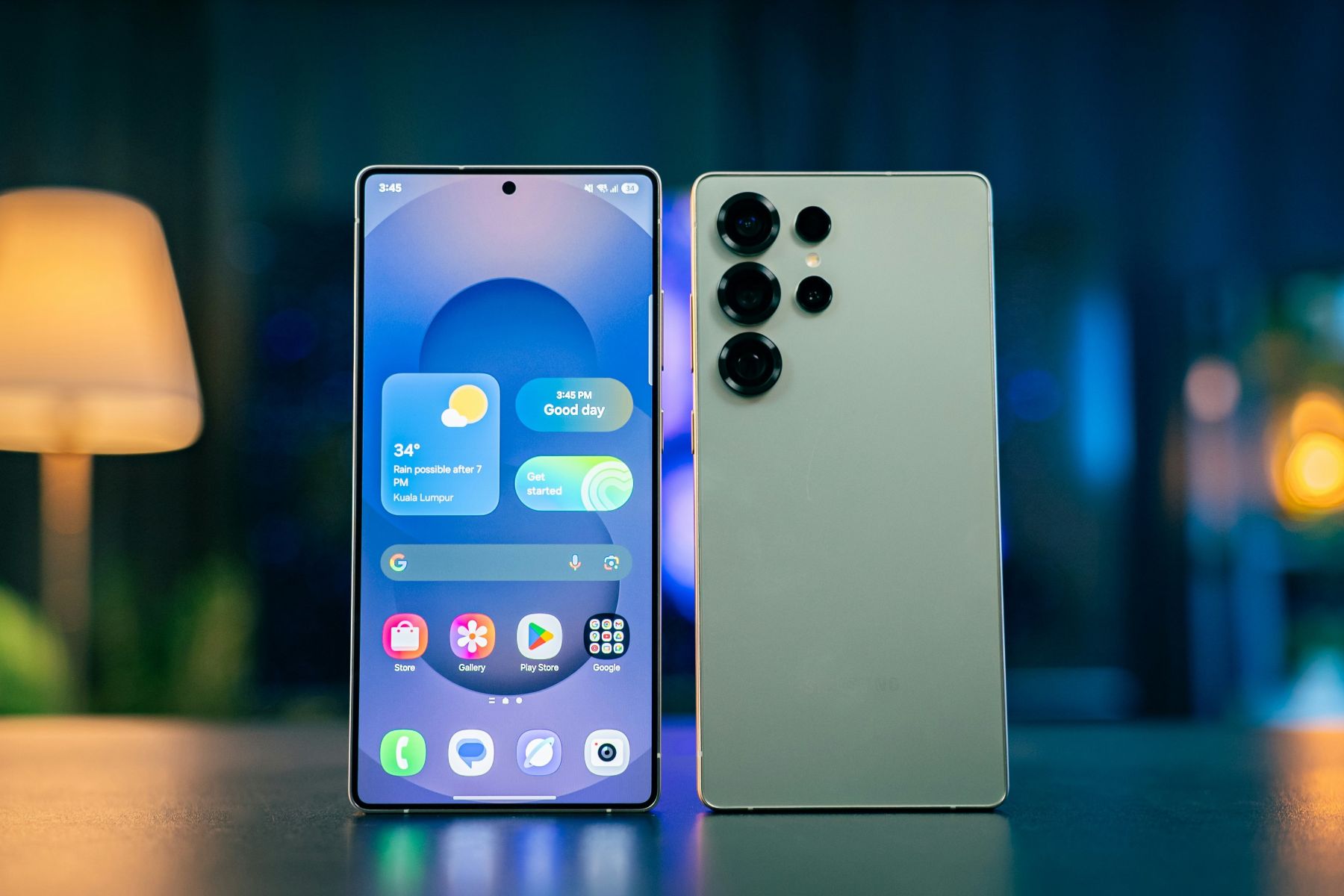Standard Samsung Galaxy S25: The Compact Champion
Starting at $799 with 128GB storage (upgradable to 512GB), the Samsung Galaxy S25 features a 6.2-inch Dynamic AMOLED 2X display with 120Hz refresh rate and 2,600 nits peak brightness. Powered by the Snapdragon 8 Elite for Galaxy chip built on 3nm technology, it delivers up to 45% better performance than its predecessor.
The camera system maintains the proven 50MP main sensor with OIS, 12MP ultra-wide, and 10MP 3x telephoto zoom, while the front features a 12MP selfie camera. Despite unchanged hardware, Samsung's new ProVisual Engine and AI enhancements deliver noticeably improved image processing and low-light performance.
User Reception: Consumer Reports notes the S25 delivers strong overall scores but finds it hard to recommend immediate upgrades for S24 owners. GSMArena highlights it as "the most compact Galaxy" with "the largest performance jump in years," though calling it "the tiniest update" in terms of new features. Users praise its one-handed usability and solid build quality, though some express disappointment about the unchanged camera hardware from the S22 era.
Samsung Galaxy S25+: The Balanced Performer
At $999, the S25+ offers a larger 6.7-inch QHD+ display with the exclusive ProScaler technology for better content upscaling. It shares the same camera setup as the base model but adds faster 45W charging (versus 25W on the base) and a larger 4,900mAh battery.
The Plus model includes 12GB RAM standard across all storage options and features a 15% larger vapor chamber cooling system compared to its predecessor, ensuring sustained performance during intensive tasks.
User Reception: Tech reviewers position the S25+ as the sweet spot for users wanting a larger screen without the Ultra's premium price. The faster charging and bigger battery address two main complaints about the base model, though some question whether the $200 premium is justified for essentially a size upgrade.
Samsung Galaxy S25 Ultra: The Productivity Powerhouse
The $1,299 S25 Ultra distinguishes itself with a 6.9-inch display (up from 6.8-inch), titanium construction, and a comprehensive camera system featuring a 200MP main sensor, new 50MP ultra-wide with macro capabilities, and dual telephoto lenses. It includes the signature S Pen, though Samsung controversially removed Bluetooth functionality this year.
The Ultra features a 40% larger vapor chamber, 5,000mAh battery with 45W charging, and exclusive Gorilla Armor 2 glass with anti-reflective coating. The refined design features softer corners compared to previous Ultra models, improving hand comfort.
User Reception: 9to5Google calls it "perfection of a prescribed formula," praising the display as "the best I've ever seen on mobile." However, power users criticize the S Pen's lost Bluetooth capabilities. The Verge notes that while it's "the thinnest Ultra model ever," the incremental updates make it feel more like refinement than revolution.
Samsung Galaxy S25 Edge: The Design Statement
Released in May 2025 at around $899, the S25 Edge measures just 5.8mm thick and weighs 163g, making it Samsung's thinnest smartphone ever. It features a 6.7-inch display, 200MP main camera paired with a 12MP secondary sensor, but makes compromises with a smaller 3,900mAh battery.
The Edge uses Gorilla Glass Ceramic 2 on the front and titanium frame construction, prioritizing aesthetics and portability over raw specifications.
User Reception: Samsung Community reviews praise its "almost unbelievable" lightweight feel and comfortable hand grip. However, critics point to battery life concerns and the lack of a telephoto lens. Users describe it as "a design marvel" that struggles with "battery limitations" and sustained performance under heavy use.
One UI 7 and Galaxy AI: The Real Story
Samsung's One UI 7, based on Android 15, brings significant AI integration across the Samsung Galaxy S25 series. New features include AI agents with multimodal capabilities, enhanced Circle to Search that recognizes phone numbers and emails instantly, and Cross App Action for seamless task execution across multiple apps.
The Now Brief feature provides personalized morning summaries including weather, calendar events, and commute times. Night Video with Audio Eraser removes unwanted background noise from recordings, while the ProVisual Engine enhances photo processing across all lighting conditions.
User Reception: Consumer Reports notes these AI features "seem genuinely useful, while others deliver more splash than substance." Users report mixed experiences, with some features working brilliantly while others feel half-baked. The consensus suggests Samsung's AI implementation is more mature than competitors but still needs refinement.
Common Criticisms Across the Samsung Galaxy S25 Line
Despite overall positive reception, users have identified consistent pain points:
- Minimal Hardware Innovation: The base and Plus models use the same camera sensors since the S22, leading to criticism about Samsung's conservative approach to hardware updates.
- Battery Life Concerns: Consumer Reports notes battery performance is "actually a hair worse" than the S24 series, though not significantly enough to impact daily use.
- S Pen Regression: The S25 Ultra's removal of Bluetooth functionality from the S Pen eliminates features like remote camera control and air gestures, frustrating long-time Note and Ultra users.
- Regional Variations: While all models use Snapdragon globally (a positive change), features like dual SIM support vary by region, with US models limited to eSIM functionality.
Should You Upgrade to the Samsung Galaxy S25?
The Samsung Galaxy S25 series presents a compelling upgrade for users with Galaxy S22 or older devices. The Snapdragon 8 Elite processor delivers meaningful performance improvements, while One UI 7's AI features genuinely enhance daily usage. Seven years of promised Android updates ensure long-term value.
For S23 and S24 owners, the upgrade case is weaker. Unless you specifically need the S25 Ultra's refined design or the Edge's ultra-thin profile, your current device likely serves you well. CNBC's analysis suggests the S25 is "well suited to consumers with phones three or four years old" but unlikely to drive premature upgrades.
Pricing and Availability
The Samsung Galaxy S25 series maintains last year's pricing despite inflation:
- Galaxy S25: $799 (128GB), $859 (256GB), $979 (512GB)
- Galaxy S25+: $999 (256GB), $1,119 (512GB)
- Galaxy S25 Ultra: $1,299 (256GB), $1,419 (512GB), $1,659 (1TB)
- Galaxy S25 Edge: $899 (256GB), $1,019 (512GB)
Pre-orders began January 22, 2025, with general availability starting February 7, 2025. The Edge model launched separately on May 13, 2025.
Final Verdict
The Samsung Galaxy S25 series succeeds through refinement rather than revolution. Samsung has delivered its most cohesive lineup yet by standardizing the Snapdragon 8 Elite across all models and focusing on AI-driven software enhancements rather than spec-sheet victories.
The standard Samsung Galaxy S25 emerges as an excellent compact flagship, offering flagship performance in a manageable size. The S25+ satisfies those wanting more screen real estate and battery life. The Ultra continues as the everything-phone for power users despite the S Pen controversy. The Edge, while niche, showcases Samsung's design capabilities.
What the Samsung Galaxy S25 series lacks in hardware innovation, it compensates with software sophistication. Galaxy AI features feel more integrated and useful than competitors' attempts, while One UI 7 represents Samsung's most polished software release yet.
For potential upgraders, the Samsung Galaxy S25 series offers meaningful improvements if you're coming from older hardware. But if you're happy with your S23 or S24, Samsung's evolutionary approach this year won't compel an immediate upgrade - and that's perfectly fine. Sometimes, perfecting the formula matters more than rewriting it.



